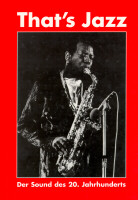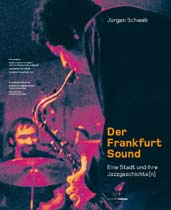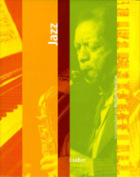That’s Jazz. Der Sound des 20. Jahrhunderts
Exhibition catalogue, Darmstadt 1988 (Editors: Annette Hauber, Ekkehard Jost, Klaus Wolbert), 723 pages [Reprint: Bochinsky-Verlag, Frankfurt/Main 1990; Reprint: Häusser-Verlag, Darmstadt, 1997]
 The Darmstadt exhibition catalog is a standard work on jazz history. Authors from many countries deal with jazz history from different perspectives. The history of American jazz is juxtaposed with that of European jazz, but topics such as jazz and literature, jazz and film, jazz and the visual arts, and others are also knowledgeably treated. is still praised worldwide as a prime example of a comprehensive jazz book and, with hundreds of photos, texts written by experts, and its appealing layout, is a standard work as well as the best birthday gift for any jazz lover. "That's Jazz. The Sound of the 20th Century is only available through bookstores, although all editions are now out of print. Nevertheless, it can be worthwhile to ask for it in second-hand bookshops - internet antiquaries are also very helpful here.
The Darmstadt exhibition catalog is a standard work on jazz history. Authors from many countries deal with jazz history from different perspectives. The history of American jazz is juxtaposed with that of European jazz, but topics such as jazz and literature, jazz and film, jazz and the visual arts, and others are also knowledgeably treated. is still praised worldwide as a prime example of a comprehensive jazz book and, with hundreds of photos, texts written by experts, and its appealing layout, is a standard work as well as the best birthday gift for any jazz lover. "That's Jazz. The Sound of the 20th Century is only available through bookstores, although all editions are now out of print. Nevertheless, it can be worthwhile to ask for it in second-hand bookshops - internet antiquaries are also very helpful here.
Jürgen Schwab: Der Frankfurt Sound. Eine Stadt und ihre Jazzgeschichte(n)
Frankfurt/Main 2004 (Societäts-Verlag), 320 pages, includes 2 CDs, ISBN 3-7973-0888-4, Euro 29,90
 "Frankfurt Sound" - this catchphrase, coined by Polish musicians in 1957, tried to sum up the specific cool jazz of the circle around Joki Freund and the Mangelsdorff brothers. At that time, numerous impulses for the national and international jazz scene emanated from Frankfurt am Main. Many a musical beacon was lit by Albert Mangelsdorff, but others also made their mark: Horst Lippmann and Fritz Rau as concert promoters, for example, or the German Jazz Federation as a lobby for jazz. Using the example of the Hesse metropolis, the "jazz capital of the republic" in the first post-war decades, this book tells the story of jazz in Germany: from the earliest astonished reflections in the face of black artists from overseas, through the dance enthusiasm of the 1920s, the criminalization during the Nazi era, the enthusiastic reconstruction work of the 1950s, to the self-evidence of jazz as an expression of contemporary art.
"Frankfurt Sound" - this catchphrase, coined by Polish musicians in 1957, tried to sum up the specific cool jazz of the circle around Joki Freund and the Mangelsdorff brothers. At that time, numerous impulses for the national and international jazz scene emanated from Frankfurt am Main. Many a musical beacon was lit by Albert Mangelsdorff, but others also made their mark: Horst Lippmann and Fritz Rau as concert promoters, for example, or the German Jazz Federation as a lobby for jazz. Using the example of the Hesse metropolis, the "jazz capital of the republic" in the first post-war decades, this book tells the story of jazz in Germany: from the earliest astonished reflections in the face of black artists from overseas, through the dance enthusiasm of the 1920s, the criminalization during the Nazi era, the enthusiastic reconstruction work of the 1950s, to the self-evidence of jazz as an expression of contemporary art.
Numerous sources and picture archives were evaluated for the first time for this publication. In words and pictures, this is a highly readable story of how jazz won over a German city and how individual citizens of this city contributed with their enthusiasm to jazz becoming an independent, inspired and at the same time critical art in this country. Two enclosed audio CDs with five hr2 radio features bring "Frankfurt's Golden Wedding Days with Jazz" back to life in musical sound documents and commentaries by contemporary witnesses.
Wolfgang Sandner (Hg.): Jazz (Handbuch der Musik im 20. Jahhrundert, Band 9)
Laaber 2005 (Laaber-Verlag), 359 Seiten, ISBN 3-89007-429-4, 72 €
 Jazz, den wichtigsten Beitrag Amerikas zur Musik des 20. Jahrhunderts, unterscheiden einige wesentliche Merkmale von anderen musikalischen Erscheinungsformen der Zeit. Der Jazz ist älter als sein Name, er war nicht als Kunstform intendiert, wiewohl man ihn, vor allem in Europa, als willkommene kulturelle Inspirationsquelle empfand. Er wurde oral tradiert und ist bis heute eine künstlerische Äußerung geblieben, die mehr als andere von der Aufführung lebt und deren historisches Vermächtnis sich nicht so sehr in Bibliotheken und Musikarchiven findet, vielmehr in Discographien. Möglicherweise trennt die erotisierende Unterhaltungsmusik, die in amerikanischen Großstadtspelunken zu Beginn des 19. Jahrhunderts erklang, auch weit mehr von den musikalischen Konzepten eines Anthony Braxton siebzig Jahre später als die Musik der Florentiner Camerata vom Licht-Zyklus eines Karlheinz Stockhausen.
Jazz, den wichtigsten Beitrag Amerikas zur Musik des 20. Jahrhunderts, unterscheiden einige wesentliche Merkmale von anderen musikalischen Erscheinungsformen der Zeit. Der Jazz ist älter als sein Name, er war nicht als Kunstform intendiert, wiewohl man ihn, vor allem in Europa, als willkommene kulturelle Inspirationsquelle empfand. Er wurde oral tradiert und ist bis heute eine künstlerische Äußerung geblieben, die mehr als andere von der Aufführung lebt und deren historisches Vermächtnis sich nicht so sehr in Bibliotheken und Musikarchiven findet, vielmehr in Discographien. Möglicherweise trennt die erotisierende Unterhaltungsmusik, die in amerikanischen Großstadtspelunken zu Beginn des 19. Jahrhunderts erklang, auch weit mehr von den musikalischen Konzepten eines Anthony Braxton siebzig Jahre später als die Musik der Florentiner Camerata vom Licht-Zyklus eines Karlheinz Stockhausen.
Essays:
- Wolfram Knauer: Historischer Überblick
- Jürgen Schwab: Stilelemente
- Reimer von Essen: Aufführungspraxis historischer Jazzstile
- Ulrich Kurth: Wirtschaft, Gesellschaft, Produktionsbedingungen
- Ulrich Kurth: Organisationsformen
- Peter Kemper: Bausteine einer sozialen Ästhetik
- Wolfgang Sandner: Der Jazz und die Künste
- Wolfram Knauer: Die Jazz-Analyse
Deutsche Jazzfotografen: Karlheinz Fürst, herausgegeben von Monika Fürst
Neckargemünd 2012 (Männeles Verlag / Jazzinstitut Darmstadt), 216 Seiten, 24,90 Euro, ISBN: 978-3-933968-20-3
 Geschichtsträchtig, aber dennoch zeitlos modern… So könnte man die Aufnahmen des deutschen Jazzfotografen Karlheinz Fürst charakterisieren. Noch jenseits digitaler Bearbeitung dokumentierte Karlheinz Fürst im Auftrag von Joachim Ernst Berendt in den Jahren 1958 bis 1963 wichtige Kapitel deutscher Jazzgeschichte mit regionalem Kolorit.
Geschichtsträchtig, aber dennoch zeitlos modern… So könnte man die Aufnahmen des deutschen Jazzfotografen Karlheinz Fürst charakterisieren. Noch jenseits digitaler Bearbeitung dokumentierte Karlheinz Fürst im Auftrag von Joachim Ernst Berendt in den Jahren 1958 bis 1963 wichtige Kapitel deutscher Jazzgeschichte mit regionalem Kolorit.
Karlheinz Fürst gehörte von Anfang an zu den fotografischen Pionieren in dem kompromisslosen Verzicht auf Blitzlicht zugunsten des künstlerischen Ausdrucks. Die auf den ersten Blick scheinbare Unschärfe und Grobkörnigkeit etablierte sich unter den künstlerischen Fotografen schnell zu einem ausgesuchten Stilmittel.
Aus Anlass einer Ausstellung im Jazzinstitut Darmstadt erschien nun der zweite Band der Reihe “Deutsche Jazzfotografen” mit Fotos von Karlheinz Fürst. Der von der Tochter des Fotografen Marion Fürst in Zusammenarbeit mit dem Jazzinstitut Darmstadt herausgegebene Band “Deutsche Jazzfotografen: Karlheinz Fürst” ist 216 Seiten stark und enthält neben den ausdrucksstarken Fotos aus den 1950er und frühen 1960er Jahren einen sehr persönlichen Aufsatz der Herausgeberin sowie einen kenntnisreichen Rückblick auf die deutsche Jazzszene jener Zeit von Matthias Spindler.[:]